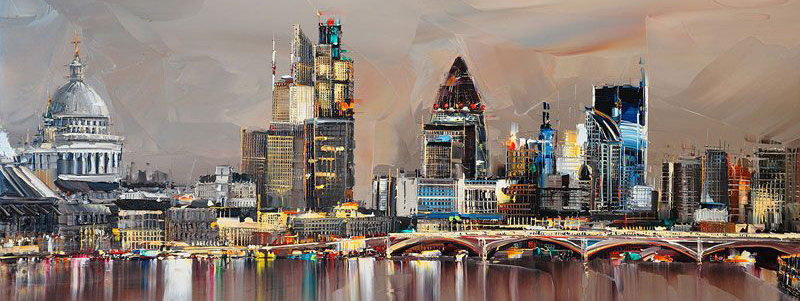Bloomsbury - Highgate
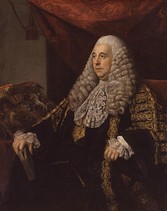 Camden Town is a neighbourhood situated in the Camden borough. It gets its name from Charles Pratt, the Marquis of Camden, who lived here until 1974, and whose property occupied the centre of the area. During the Victorian age it was far from being a safe neighbourhood, and was connected to the criminal underworld. Dickens too, lived here as a child, more precisely in Bayham Street. As far back as 1981, it had less than two hundred thousand inhabitants. In time, thanks to the stations of Euston, St Pancras and King's Cross, urbanization has gradually increased. Today Camden is a multiethnic neighbourhood, a trendy location, much loved by young people and a gathering spot for artists and students. It is well-known for its markets and for being a place of liberality and a home to popular culture venues and associations. In 1960 the Roundhouse, which was a previously a steam-engine repair shed, was converted into a theatre and a centre for alternative culture. The main attraction however, is still the huge marketplace known as Camden Market, where one may find just about anything, in particular items of leather clothing. In 1873, when Paul Verlaine and Rimbaud arrived in London, they went to stay at the Lodging House, which was at the time located at the address of 8, Royal College Street. The building was a shambles and gave an idea of the extremely poor conditions of the two poets, who nonetheless used to muster their keep by offering the odd French lesson.
Camden Town is a neighbourhood situated in the Camden borough. It gets its name from Charles Pratt, the Marquis of Camden, who lived here until 1974, and whose property occupied the centre of the area. During the Victorian age it was far from being a safe neighbourhood, and was connected to the criminal underworld. Dickens too, lived here as a child, more precisely in Bayham Street. As far back as 1981, it had less than two hundred thousand inhabitants. In time, thanks to the stations of Euston, St Pancras and King's Cross, urbanization has gradually increased. Today Camden is a multiethnic neighbourhood, a trendy location, much loved by young people and a gathering spot for artists and students. It is well-known for its markets and for being a place of liberality and a home to popular culture venues and associations. In 1960 the Roundhouse, which was a previously a steam-engine repair shed, was converted into a theatre and a centre for alternative culture. The main attraction however, is still the huge marketplace known as Camden Market, where one may find just about anything, in particular items of leather clothing. In 1873, when Paul Verlaine and Rimbaud arrived in London, they went to stay at the Lodging House, which was at the time located at the address of 8, Royal College Street. The building was a shambles and gave an idea of the extremely poor conditions of the two poets, who nonetheless used to muster their keep by offering the odd French lesson. Boat transit on Regent's Canal One can reach Camden by boat from Little Venice and vice versa - via Regent's Canal. The route winds by the large pontoons anchored along the canal and between arrays of charming villas. It also passes through a tunnel where the handrails bear the deep marks etched by towing hawsers dating back to earlier than 1950, when watercraft used to be pulled along by horses. From here, one can also observe flights of steps used for leading horses back onto the road when they had fallen into the water.
There is a bridge on the canal, called Macclesfield Bridge which goes by the nickname Blow-out bridge. The name refers to it hosting the biggest explosion to ever take place before the Great War, when a barge loaded with gun powder exploded in 1874. Silence and tranquillity can be found amid the trees in Regent's Park, where they grow on the banks of the canal, their foliage stooping down towards the water, as the boat glides gently along enveloped in silence.
In addition to the fascinating scenery, one can witness the lock system in action, which allows vessels to overcome the difference in height between different segments of the canal; the whole system is still manually driven, in the traditional way. In the stretch of canal which crosses through the zoo, one can admire gazelles as they sprint away, and hear the birdsongs of tropical species. A floating Chinese restaurant, just a little way up ahead, gives us the impression of being in Asia. Then, one is dropped off in the centre of the market in Camden Lock. The Modena City Ramblers, a popular Italian folk-rock band, have written a charming song about this canal: “I want stay here sitting down for a while / to finish up my glass / and watch the sleeping boats /on the banks of Regent's canal / here, one cannot hear the traffic / which bustles along Camden High Street. / Only the wind brings the voices of men / as they return from the last pub. / Silence brings the great city to its slumber / cradled beneath the Moon / it closes the eyes of tramps in their sleeping bags / under the shelter of Waterloo Bridge...”
Camden Lock The most well-known part here is the market place, specialized in clothing, handcrafted objects, and antique items, all shrouded by the exotic perfume of incense and joss sticks which smoulder ceaselessly. It has existed since 1975 and one may also find board games and films for sale. Camden Lock Village is another interesting spot. There are many shops, some of them quite unusual, such as that selling various types of percussions, or a small workshop which carries out engraving on glass. The buildings of the old warehouses, the system of locks which has remained intact, and the distinctive old pubs all contribute towards making this spot a unique and fascinating location.
JEWISH MUSEUM
129 -131 ALBERT STREET
UNDERGROUND: CAMDEN TOWN
This museum is just a few minutes away from the Camden Underground, and inside, over six centuries of Hebrew culture and lifestyle are exhibited in the form of paintings, clothes, silverware, photographs, items of ritual art, embroidery, manuscripts, documents, and recorded interviews. It also hosts an interesting photo archive, showing the life of the Jewish community in London throughout history, the roots of daily life in East End, the ordeal of the refugees and the survivors of the Holocaust.
A place of honour has been given to an Ark, crafted in Venice in the Seventeenth Century, gilded and decorated with inlaid symbols, which harbours the Torah scrolls. The museum has been here since 1995. Some very compelling events are often organized here, as well as contemporary exhibitions.
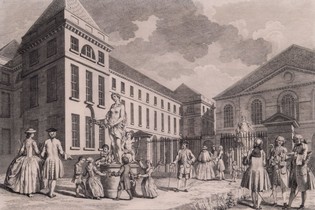 Bloomsbury gets its name from the Blemond family, which once owned a vast portion of its lands. Here, during the Eleventh Century there used to be vineyards and woods, where dozens of pigs would scour the earth for truffles. Later, King Edward III gave these lands to the Carthusian monks and the area became monastery grounds. After Henry VIII ordered its disbandment, the land was acquired by the count of Southampton. His son then built Southhampton House there, including a lovely garden in its centre, and also the surrounding servants' houses. The old garden later became Bloomsbury Square, and in the following years other important families came to live here, such as the Bedford, the Russell, and the Montagu families, whom the streets and squares in the neighbourhood were named after.
Bloomsbury gets its name from the Blemond family, which once owned a vast portion of its lands. Here, during the Eleventh Century there used to be vineyards and woods, where dozens of pigs would scour the earth for truffles. Later, King Edward III gave these lands to the Carthusian monks and the area became monastery grounds. After Henry VIII ordered its disbandment, the land was acquired by the count of Southampton. His son then built Southhampton House there, including a lovely garden in its centre, and also the surrounding servants' houses. The old garden later became Bloomsbury Square, and in the following years other important families came to live here, such as the Bedford, the Russell, and the Montagu families, whom the streets and squares in the neighbourhood were named after.On the corner of Russell Square, which now hosts a school for oriental studies, there is a building which bears a plaque reminding us of the fact that the poet T.S. Eliot once worked here as the editor of Faber & Faber. On the eastern side of the square we can admire a looming building with red bricks, which is Russell Hotel. On the second Sunday of January,
The Bloomsbury Book Fair is held within the building's magnificent ballroom. To one side of the garden in the centre of the square, we find the taxi drivers' shelter, one of the small green houses where drivers can stop for a quick bite and some tea. 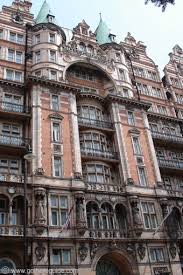 Bloomsbury is famous for being an intellectual neighbourhood and this is also due to the fact that a group of writers, artists and scholars the Bloomsbury Group once used to gather at 46, Gordon Square, around the year 1910, at Virginia Woolf's home. At number 2, Percy Street, (now moved to Southwark Street) there is a fascinating gallery which goes by the name of Contemporary Applied Arts. Ordinary objects can be seen here too, such as a pair of earrings or a teapot, yet they are presented with an engraved plaque as if they were relics being exhibited in a museum.
Bloomsbury is famous for being an intellectual neighbourhood and this is also due to the fact that a group of writers, artists and scholars the Bloomsbury Group once used to gather at 46, Gordon Square, around the year 1910, at Virginia Woolf's home. At number 2, Percy Street, (now moved to Southwark Street) there is a fascinating gallery which goes by the name of Contemporary Applied Arts. Ordinary objects can be seen here too, such as a pair of earrings or a teapot, yet they are presented with an engraved plaque as if they were relics being exhibited in a museum.
 Bloomsbury is famous for being an intellectual neighbourhood and this is also due to the fact that a group of writers, artists and scholars the Bloomsbury Group once used to gather at 46, Gordon Square, around the year 1910, at Virginia Woolf's home. At number 2, Percy Street, (now moved to Southwark Street) there is a fascinating gallery which goes by the name of Contemporary Applied Arts. Ordinary objects can be seen here too, such as a pair of earrings or a teapot, yet they are presented with an engraved plaque as if they were relics being exhibited in a museum.
Bloomsbury is famous for being an intellectual neighbourhood and this is also due to the fact that a group of writers, artists and scholars the Bloomsbury Group once used to gather at 46, Gordon Square, around the year 1910, at Virginia Woolf's home. At number 2, Percy Street, (now moved to Southwark Street) there is a fascinating gallery which goes by the name of Contemporary Applied Arts. Ordinary objects can be seen here too, such as a pair of earrings or a teapot, yet they are presented with an engraved plaque as if they were relics being exhibited in a museum. BRITISH MUSEUM
GREAT RUSSELL STREET
UNDERGROUND: HOLBORN, RUSSELL SQUARE
One can almost lose oneself among the antiquities held within , as one wanders through ancient Rome, Greece, the Middle Ages, Oriental relics, printed material, illustrations, coins, medals, and more... When visiting for the first time, it is advisable to walk slowly through the vast arcades and halls, in order to get a general idea of the sheer amount of things to see. One may then return a second time to concentrate on the objects that have piqued one's interest.
It had all begun in 1753, with the acquisition of the Hans Sloane library, as well as the manuscripts and the collector's items of botany and natural history. Then, the 19th century brought a number of prized and rich additions: the Rosetta Stone, Egyptian sculptures, the Parthenon friezes, a Syrian bas-relief, the remains of various tombs, and fragments of the temple of Arthemis. At that point, it became necessary to build a new location of a much larger size. Also the gallery of Mexican and pre-Columbian art is quite something. Amongst the relics of the Roman period, we find some silver remains found by a farmer who was ploughing his field in Suffolk.
The courtyard of the museum, known as Great Court, had its roofing built by Norman Foster.
At 49, Great Russell Street, we find the Museum Tavern, an old-style pub, with coloured and adorned windows, wooden sculpted decorations, carpets, curtains, and velvet. It is said that Karl Marx, who was a regular customer, once broke one of the mirrors with a punch, during a heated discussion about politics. Both the varieties of beer and the food served here follow tradition: fish and chips, sausages, potato purée, and meat pies.
ANTHONY PANIZZI'S BRITISH LIBRARY
96 EUSTON ROAD
UNDERGROUND: KING'S CROSS, ST. PANCRAS
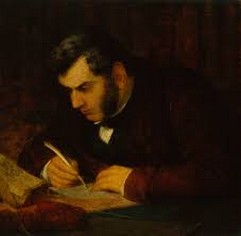 Antonio Genesio Panizzi, better-known as Anthony Panizzi, was Italian by birth, but then became a naturalized British citizen. Panizzi was born in Brescello, in the province of Reggio Emilia. He had got his degree in Law at the University of Parma in 1818. He was part of a secret society which had the objective of unifying Italy and helping it to achieve independence. During that period, Reggio Emilia was governed by Francis IV, Duke of Modena. In 1820, the wave of arrests which ensued after the assassination of the head of Police of the Duchy of Modena led him to expatriate to Switzerland, where he published a book, exposing and condemning the repression. This volume was the reason for him being brought before a court and sentenced to death in absentia. After receiving strong pressures in favour of his expulsion, Panizzi decided to move to England. In London, Ugo Foscolo, who was living in the city, having been exiled from Italy, gave him a presentation letter for the banker William Roscoe, based in Liverpool. He was working as an Italian teacher; however the wages left much to be desired. In 1826, Panizzi met with the lawyer and politician Henry Brougham and when the latter became chancellor of the Kingdom, he assigned Panizzi to the position of Italian professor at the University of London and gave him a job at the library of the British Museum.
Antonio Genesio Panizzi, better-known as Anthony Panizzi, was Italian by birth, but then became a naturalized British citizen. Panizzi was born in Brescello, in the province of Reggio Emilia. He had got his degree in Law at the University of Parma in 1818. He was part of a secret society which had the objective of unifying Italy and helping it to achieve independence. During that period, Reggio Emilia was governed by Francis IV, Duke of Modena. In 1820, the wave of arrests which ensued after the assassination of the head of Police of the Duchy of Modena led him to expatriate to Switzerland, where he published a book, exposing and condemning the repression. This volume was the reason for him being brought before a court and sentenced to death in absentia. After receiving strong pressures in favour of his expulsion, Panizzi decided to move to England. In London, Ugo Foscolo, who was living in the city, having been exiled from Italy, gave him a presentation letter for the banker William Roscoe, based in Liverpool. He was working as an Italian teacher; however the wages left much to be desired. In 1826, Panizzi met with the lawyer and politician Henry Brougham and when the latter became chancellor of the Kingdom, he assigned Panizzi to the position of Italian professor at the University of London and gave him a job at the library of the British Museum.Here Panizzi made his career, going from the position of library assistant to director. Under his guide, the number of books went from two hundred and thirty thousand to more than half a million. He was also involved in a few controversial incidents, such as that involving Thomas Carlyle. He created a new catalogue and in 1841, established ninety new rules for indexing, which became the basis for the system which is still used today and which even lies at the origin of digital indexing. Panizzi reinforced the system for copyrighting and ensured that editors were required by law to deposit one copy in the library of each and every book published in Great Britain. In 1869 he was knighted by Queen Victoria.
The circular Reading Room was designed and built by the architect Sydney Smirke, starting from a rough sketch drawn by Panizzi. It had been opened in 1857. The Reading Room was used until 1997, and then the library was transferred to St Pancras.
THE HORSE HOSPITAL
COLONNADE
UNDERGROUND: RUSSELL SQUARE
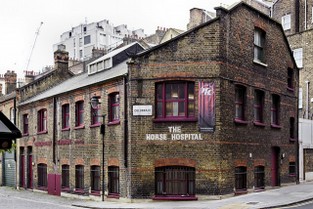 The building that hosts the horse Hospital and stands in the middle of a lovely little paved lane between Bernard Street and Guilford Street was in fact a shelter for horses. In 1993 it was converted into a contemporary art gallery and auction house. It is a rather unusual gallery, and the exhibitions that are held there often have specific aims, such as protest, such as, for example the demonstration in favour of nuclear disarmament. There is also a room dedicated to pop culture. The gallery was founded in 1993 by Richard Burton who has worked with Vivienne Westwood, whose creations were shown in a retrospective exhibition. In the basement of the building there is a collection of modern clothing, which is rented for films.
The building that hosts the horse Hospital and stands in the middle of a lovely little paved lane between Bernard Street and Guilford Street was in fact a shelter for horses. In 1993 it was converted into a contemporary art gallery and auction house. It is a rather unusual gallery, and the exhibitions that are held there often have specific aims, such as protest, such as, for example the demonstration in favour of nuclear disarmament. There is also a room dedicated to pop culture. The gallery was founded in 1993 by Richard Burton who has worked with Vivienne Westwood, whose creations were shown in a retrospective exhibition. In the basement of the building there is a collection of modern clothing, which is rented for films.A LIFE SCHOOL
70, MARCHMONT STREET
UNDERGROUND: RUSSELL SQUARE
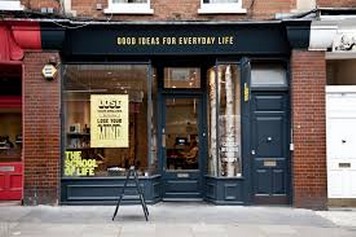 The School of life may look like just another shop, but in actual fact it proposes a philosophy of life. It was founded by Sophie Howarth, who has a team of collaborators which includes writers, artists, actors, and intellectuals. In this place, one can receive medicine for one's mind, with writers and artists acting as the pharmacists. At the back of the shop, courses are held on life's central themes: work, free time, family, politics, and love. There are also consultations, meditation lessons, and particular psychotherapy sessions, as well as evening dinners to revive the skills of conversation, and activities which take place in improbable settings, forcing the participants to tap into unknown resources which lie deep within themselves. Written works are used to help one to meditate. These activities take place in the team conferences, and all this is aimed at stimulating the creativity of all those attending.
The School of life may look like just another shop, but in actual fact it proposes a philosophy of life. It was founded by Sophie Howarth, who has a team of collaborators which includes writers, artists, actors, and intellectuals. In this place, one can receive medicine for one's mind, with writers and artists acting as the pharmacists. At the back of the shop, courses are held on life's central themes: work, free time, family, politics, and love. There are also consultations, meditation lessons, and particular psychotherapy sessions, as well as evening dinners to revive the skills of conversation, and activities which take place in improbable settings, forcing the participants to tap into unknown resources which lie deep within themselves. Written works are used to help one to meditate. These activities take place in the team conferences, and all this is aimed at stimulating the creativity of all those attending.POLLOCK'S TOY MUSEUM
SCALA STREET
UNDERGROUND: GOODGE STREET
It is worth seeing it, if only from the outside. An enchanting trompe l'oeuil on the facade forms a blend of various peculiarities in the fake painted windows: this goes from Harlequin to Russian dolls, from the circus arena to clowns and seahorses, and many more details... These windows, together with the real one in the centre are part of an enormous painted rococo curtain, with golden bows and edges, which also holds a plaque with an inscription.
THE EISENHOWER BOMB SHELTER
CHENIES STREET
UNDERGROUND: GOODGE STREET
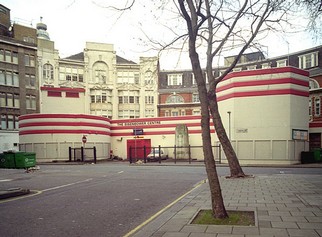 When in London, you will come across a great number of bizarre forms of architecture, and you may often wonder what it is that you are admiring. Amongst them, is the imposing fort, built during the Second World War, which stands on a side street of Tottenham Court Road, directly in front of Goodge Street Station. It somewhat resembles a huge cake with icing sugar, possibly due to its strawberry-red and whipped-cream white hues. It was once one of the two entrances to the headquarters of General Eisenhower, and it was from here that the latter, as supreme commander of the allied forces, directed the D-Day landing. This refuge was linked to the Cabinet War Rooms, where Churchill and the members of his government would gather. This connection took place via pneumatic tube transport, a system of pipes, working by means of compressed air. A provision effective to-date establishes that if these refuges were ever necessary for national security, the government could still requisition them with immediate effect.
When in London, you will come across a great number of bizarre forms of architecture, and you may often wonder what it is that you are admiring. Amongst them, is the imposing fort, built during the Second World War, which stands on a side street of Tottenham Court Road, directly in front of Goodge Street Station. It somewhat resembles a huge cake with icing sugar, possibly due to its strawberry-red and whipped-cream white hues. It was once one of the two entrances to the headquarters of General Eisenhower, and it was from here that the latter, as supreme commander of the allied forces, directed the D-Day landing. This refuge was linked to the Cabinet War Rooms, where Churchill and the members of his government would gather. This connection took place via pneumatic tube transport, a system of pipes, working by means of compressed air. A provision effective to-date establishes that if these refuges were ever necessary for national security, the government could still requisition them with immediate effect. A THEATRE IN THE DRILL HALL
16, CHENIES STREET
UNDERGROUND: GOODGE STREET
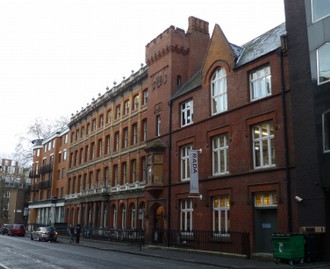 The name 'Drill Hall' is a reminder of the original military function of these rooms, where the Bloomsbury riflemen would train. For some time now, however, they have hosted a theatre, rehearsal rooms, and areas for courses. Diaghilev performed here too, with his Russian ballet. Present day shows go from Shakespeare's Macbeth to avant-garde productions. The café opens one hour before the shows start, and has a relaxing atmosphere about it. There is a children's corner, which has been fulfilled with a great deal of consideration, with particular regards to children under five. There is a wide variety of toys available and an actor who reads out stories.
The name 'Drill Hall' is a reminder of the original military function of these rooms, where the Bloomsbury riflemen would train. For some time now, however, they have hosted a theatre, rehearsal rooms, and areas for courses. Diaghilev performed here too, with his Russian ballet. Present day shows go from Shakespeare's Macbeth to avant-garde productions. The café opens one hour before the shows start, and has a relaxing atmosphere about it. There is a children's corner, which has been fulfilled with a great deal of consideration, with particular regards to children under five. There is a wide variety of toys available and an actor who reads out stories. At 21, Foley street we find the restaurant Back to Basics, a simple and charming spot, with a menu which changes every day and fifteen different fish-based dishes. In the summer, there are tables outside and small folk groups perform. The seagulls who live here and the setting of the restaurant give one the impression of being very near the sea. If one prefers Indian cuisine, the nearby Rasa Express, at 5, Rathbone Street, with its lilac facade, serves a delicious and unusual dish. It goes by the name of Rasa Meal Box and it is in fact the same meal that is served in a small lunchbox on Kerala trains. There is also a vegetarian version with rice and spicy vegetables.
THE WAX STATUE OF JEREMY
GOWER STREET
UNDERGROUND: GOODGE STREET
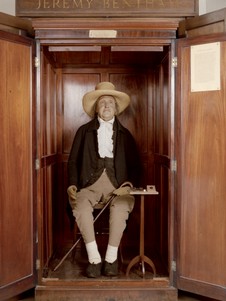 The University College, founded in 1826, later led to the creation of the University of London, the first English institution not to require a religious qualification in order to enrol. The gigantic light-grey structure with a beautiful arcade was fulfilled in Soviet-style architecture. During the war, it was the headquarters for the Ministry of Information and inspired George Orwell for his novel 1984.
The University College, founded in 1826, later led to the creation of the University of London, the first English institution not to require a religious qualification in order to enrol. The gigantic light-grey structure with a beautiful arcade was fulfilled in Soviet-style architecture. During the war, it was the headquarters for the Ministry of Information and inspired George Orwell for his novel 1984. Jeremy Bentham was a philosopher, and the creator of the theory of utilitarianism. He also fought for the separation of Church from State, the freedom of expression, women's rights, the end of slavery, the abolition of physical punishment, the right to divorce, the decriminalization of homosexuality, and the abolition of the death penalty. Although he was already elderly by the time the university was created, there is no denying that his idea that education needed to be more widespread was at the root of the creation of the institution. Bentham asked that after death his body be used for dissection for an anatomy lesson. His skeleton, provided with a wax head and fully dressed, had been placed at the entrance, however it was subjected to practical jokes by the students, and was therefore moved into a wardrobe to be taken out only during special occasions.
THE FOUNDLING SHELTER
40, BRUNSWICK SQUARE
UNDERGROUND: RUSSELL SQUARE
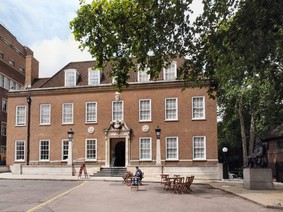 The sad scene of illegitimate children born into poverty, foundlings who lived on the streets eating leftovers, struck a chord in the heart of Thomas Coram, who decided to have a refuge erected for them. On 17th October 1739, King George II authorized the opening of the institute for the raising and education of abandoned children, the Foundling Hospital. Coram bought a strip of land at Lamb's Conduit Field and constructed the building on it. The remaining part was used for building playgrounds.
The sad scene of illegitimate children born into poverty, foundlings who lived on the streets eating leftovers, struck a chord in the heart of Thomas Coram, who decided to have a refuge erected for them. On 17th October 1739, King George II authorized the opening of the institute for the raising and education of abandoned children, the Foundling Hospital. Coram bought a strip of land at Lamb's Conduit Field and constructed the building on it. The remaining part was used for building playgrounds. HOLBORN VIADUCT
UNDERGROUND: HOLBORN
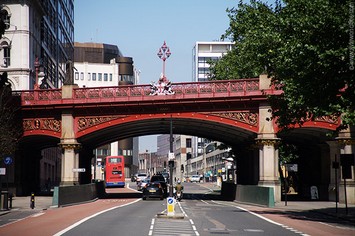 This is the name given to the great bridge which connects Holborn with Newgate Street in the City, and crosses over Farringdon Street. It was built between 1863 and 1869, following the design carried out by the architect William Heywood, in order to allow the street to continue at the same level without it having to descend down to the bottom of the valley which lies between Holborn and the City. It cost over two million pounds and the official opening was hosted by Queen Victoria, simultaneously to that of Blackfriar's Bridge.
This is the name given to the great bridge which connects Holborn with Newgate Street in the City, and crosses over Farringdon Street. It was built between 1863 and 1869, following the design carried out by the architect William Heywood, in order to allow the street to continue at the same level without it having to descend down to the bottom of the valley which lies between Holborn and the City. It cost over two million pounds and the official opening was hosted by Queen Victoria, simultaneously to that of Blackfriar's Bridge. From Farringdon Street, its decorations appear much like classic Victorian adornments. At the extremities of the bulwarks there are the four bronze statues representing Commerce, Agriculture, Science and Fine Art. Beneath the bulwarks one can make out two silver griffins portrayed as they flicker their tongues and make up the rear side of a stem.
At the corners of the bridge there are four buildings, which used to host the flights of stone steps once used for reaching the street overhead. At the tops of these buildings a few winged lions stand proudly.
Arriving from Ludgate Circus, if one happened to walk down the middle of Farringdon Street a little risky, perhaps! one would find oneself proceeding along the underground tracts of the river Fleet.
LINCOLN'S FIELDS
UNDERGROUND: HOLBORN
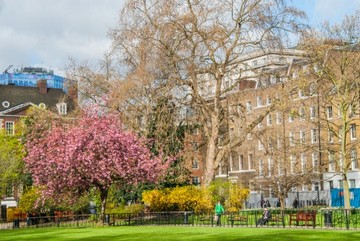 In 1638, William Newton had obtained permission to build thirty-two houses along the green area of Lincoln's Inn Fields. One of the original buildings still survives to date between street numbers 59-60, possibly drafted and planned by Inigo Jones. At the north-western corner lies Newcastle House, which still bears some traits of the Seventeenth-century building which was constructed by Captain Winde.
In 1638, William Newton had obtained permission to build thirty-two houses along the green area of Lincoln's Inn Fields. One of the original buildings still survives to date between street numbers 59-60, possibly drafted and planned by Inigo Jones. At the north-western corner lies Newcastle House, which still bears some traits of the Seventeenth-century building which was constructed by Captain Winde. At 120, Lincoln's Inn, a metal plate commemorates Thomas Ernshaw's invention: the naval chronometer, which helped make long-distance journeys much more manageable. Until 1992, the London Weather Centre was to be found on this street as well.
In Lincoln's Inn, there is also a tool hut, built for the gardener, Temple, especially in honour of the occasion of Queen Victoria's visit in 1852. It is a wonderful pavilion made in red bricks, with a stone stem in relief.
The park makes for a great opportunity to enjoy a pleasant stop after visiting the nearby museum, which we shall talk about in the following chapter.
JOHN SOANE'S MUSEUM
12-13, LINCOLN'S INN FIELDS
UNDERGROUND: HOLBORN
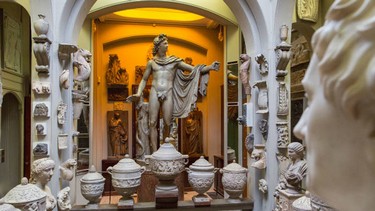 John Soane purchased the house at 12, Lincoln's Inn Fields in the year 1792. He then purchased the two houses on each side of number 12, and transformed them into a museum by hosting his collection of paintings, sculptures, porcelains, clocks, furniture, glass walls, small models of monuments and buildings... and the list goes on. There is also a sarcophagus made of alabaster of Seti I, which originates from the far away Valley of the Kings in Egypt. Also to be found are two series of paintings carried out by Hogarth, and three by Canaletto. The rooms are unusual; they have a very personal character about them and have in fact been preserved and kept as he had left them. The dining room looks out over a delightful internal courtyard. The museum is the most precious memory of Soane the architect, also due to the fact that his buildings, such as the Law Court in Westminster, and the Privy Council Room in Whitehall have all been either destroyed, modified, or burnt down in time.
John Soane purchased the house at 12, Lincoln's Inn Fields in the year 1792. He then purchased the two houses on each side of number 12, and transformed them into a museum by hosting his collection of paintings, sculptures, porcelains, clocks, furniture, glass walls, small models of monuments and buildings... and the list goes on. There is also a sarcophagus made of alabaster of Seti I, which originates from the far away Valley of the Kings in Egypt. Also to be found are two series of paintings carried out by Hogarth, and three by Canaletto. The rooms are unusual; they have a very personal character about them and have in fact been preserved and kept as he had left them. The dining room looks out over a delightful internal courtyard. The museum is the most precious memory of Soane the architect, also due to the fact that his buildings, such as the Law Court in Westminster, and the Privy Council Room in Whitehall have all been either destroyed, modified, or burnt down in time.At number 24, in the nearby Old Gloucester Street, inside a beautiful building which somewhat gives one the impression of being in Amsterdam, one can visit the October Gallery, which contains exhibitions of artists from all over the world, ranging from Africa to New Zealand. Here, films are screened and conferences are held as well.
THE OLD CURIOSITY SHOP
13-14, PORTSMOUTH STREET
UNDERGROUND: HOLBORN
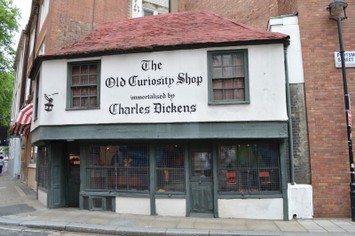 The small house in Portsmouth Street is not far from the London residence of Charles Dickens, in Doughty Street, which has now been converted into a museum. It is a known fact that the writer paid a number of visits to this shop, which dates back to halfway through the Sixteenth Century and has exposed beams.
The small house in Portsmouth Street is not far from the London residence of Charles Dickens, in Doughty Street, which has now been converted into a museum. It is a known fact that the writer paid a number of visits to this shop, which dates back to halfway through the Sixteenth Century and has exposed beams.It is thought that the shop served him as a model for the description of the house of Little Nell and her grandfather in The Old Curiosity Shop. Originally this small building was a dairy factory belonging to the holdings owned by Charles II, given as a present from the king to one of his lovers, namely the Duchess of Portsmouth. It is certainly the oldest among all the shops in central London and gives some idea of what the city must have looked like before the Great Fire of London, which ravaged the area in 1666. Today it is home to a shoe shop .
JAMES SMITH'S UMBRELLAS
NEW OXFORD STREET
UNDERGROUND: HOLBORN
ST. ANDREW HOLBORN PARISH
5, HOLBORN CIRCUS
UNDERGROUND: CHANCERY LANE, FARRINGDON
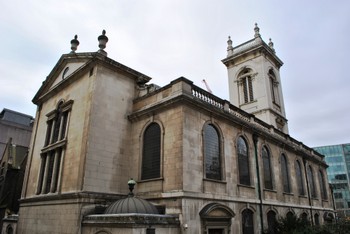 This church, which draws its origins all the way back to the Middle Ages, was rebuilt by Wren at the end of the Seventeenth Century. It is the largest of all the churches built by him. Today it is the church of a corporation and is open to workers of the surrounding areas. This striking crypt, with its medieval foundations and Wren's vaults, is used for concerts and theatre work. In a small chapel beneath the tower lies the tomb of commander Thomas Coram, founder of the shelter for abandoned children. A marble cherub weeps for the man who did so much for so many of them.
This church, which draws its origins all the way back to the Middle Ages, was rebuilt by Wren at the end of the Seventeenth Century. It is the largest of all the churches built by him. Today it is the church of a corporation and is open to workers of the surrounding areas. This striking crypt, with its medieval foundations and Wren's vaults, is used for concerts and theatre work. In a small chapel beneath the tower lies the tomb of commander Thomas Coram, founder of the shelter for abandoned children. A marble cherub weeps for the man who did so much for so many of them. The organ found inside is particularly important because it comes from Coram's shelter. It had been Handel himself who had given it to him in 1750. In front of the church, at the centre of Holborn Circus, there is a bronze statue of the prince consort, who appears to be greeting the beholder politely, as he removes his cocked hat. This masterpiece was pieced together by Charles Bacon.
THE CAMBRIDGESHIRE STRAWBERRY FAIR
UNDERGROUND: CHANCERY LANE , FARRINGDON
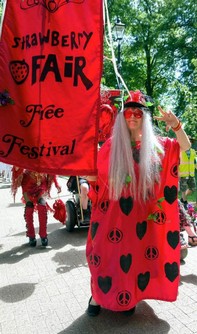 This Medieval corner of Ely Place, peaceful and quiet, is not technically a part of London, and belongs in fact to Cambridgeshire. Here stands the residency of the Ely bishop and still today it is made up of Eighteenth-century houses, with a iron gate at its edges. It was built in 1772 by Robert Taylor at Ely Palace, of which there are many references in Shakespeare's comedies. In fact this is the place where the author has John of Gaunt pronounce the famous speech on the scepter'd isle.
This Medieval corner of Ely Place, peaceful and quiet, is not technically a part of London, and belongs in fact to Cambridgeshire. Here stands the residency of the Ely bishop and still today it is made up of Eighteenth-century houses, with a iron gate at its edges. It was built in 1772 by Robert Taylor at Ely Palace, of which there are many references in Shakespeare's comedies. In fact this is the place where the author has John of Gaunt pronounce the famous speech on the scepter'd isle.For more than five hundred years, along this strip of road, the Strawberry Fair has been held every second Sunday of June. The strawberries used to come from the bishops plantations, and it was said that they were the tastiest in all London. They are even mentioned in Shakespeare's Richard III.
At the nearby Ely Court, between Hatton Garden and Ely Place, stands the pub Ye Olde Mitre. The indoor area dates back to the Eighteenth Century. A glass pane shields the remains of a cherry tree which used to stand in the garden area, which is now taken up by the inn itself. There is also another historical pub in this area, called the Jerusalem Tavern, in Britton Street.
THE SCOTCH WHISKY SOCIETY
19 GREVILLE STREET
UNDERGROUND: FARRINGDON
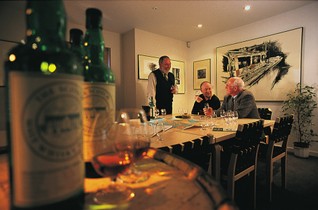 The Whisky Society is hosted within a classical Victorian building, within an environment which is both elegant and cocoon-like. In-between the walls of the Member's Room, which are covered by extremely shiny wooden panels, pleasure and business are mixed, as the members sit on leather armchairs in front of the burning fireplace, holding a glass of malt whisky chosen from the vastest variety to be found anywhere in the whole city. A good deal of information about the preparation of this amber drink can be gained here, and there are also audio-visual explanations, as well as tasting sessions, all making for some very pleasant evenings. One may only enter if accompanied by a member.
The Whisky Society is hosted within a classical Victorian building, within an environment which is both elegant and cocoon-like. In-between the walls of the Member's Room, which are covered by extremely shiny wooden panels, pleasure and business are mixed, as the members sit on leather armchairs in front of the burning fireplace, holding a glass of malt whisky chosen from the vastest variety to be found anywhere in the whole city. A good deal of information about the preparation of this amber drink can be gained here, and there are also audio-visual explanations, as well as tasting sessions, all making for some very pleasant evenings. One may only enter if accompanied by a member. CHURCH OF ST ETHELDREDA
14, ELY PLACE
UNDERGROUND: FARRINGDON, CHANCERY LANE
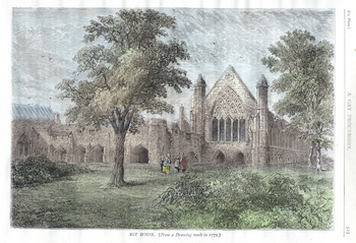 Once, this church was the private palace of the bishop of Ely in London. It was built in 1290 and in 1873 it was purchased by the Rosminian fathers of charity. It is the oldest building used by the Catholic Church in London, from the times when Edward I reigned. The windows portray the followers executed in Tyburn as punishment for their creed. A point of beauty is the ceiling, made in wood. The crypt contains part of an Ancient Roman basilica, and within a golden reliquary, a piece of St Etheldreda's hand has been preserved.
Once, this church was the private palace of the bishop of Ely in London. It was built in 1290 and in 1873 it was purchased by the Rosminian fathers of charity. It is the oldest building used by the Catholic Church in London, from the times when Edward I reigned. The windows portray the followers executed in Tyburn as punishment for their creed. A point of beauty is the ceiling, made in wood. The crypt contains part of an Ancient Roman basilica, and within a golden reliquary, a piece of St Etheldreda's hand has been preserved. There is also a small café inside the crypt, facing the cloister.
BLEEDING HEART YARD
UNDERGROUND: FARRINGDON
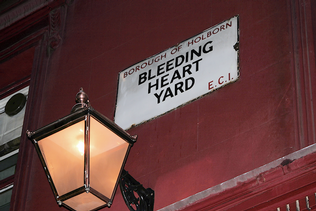 Bleeding Heart Yard is a paved courtyard, which lies diagonally to Greville Street. According to an urban legend, the name commemorates the murder of Elizabeth Hatton, the second wife of William Hatton, whose family owned the surrounding area. It is said that on the 27th January 1626 her body was found here, torn to shreds, but with her heart still beating. In some stories written by Barnham halfway through the Nineteenth Century, Lady Hatton makes a pact with the Devil and during the house opening party, the Devils, after first dancing with her, rips out her heart, which is found the following day, still beating. It is from this story, and thanks to some confusion regarding the identities of those involved, that this legend was born, and is still spoken of to date. In actual fact, this area gets its name from a sign belonging to a pub in Charles Street, which portrayed the heart of the Virgin Mary pierced by five swords.
Bleeding Heart Yard is a paved courtyard, which lies diagonally to Greville Street. According to an urban legend, the name commemorates the murder of Elizabeth Hatton, the second wife of William Hatton, whose family owned the surrounding area. It is said that on the 27th January 1626 her body was found here, torn to shreds, but with her heart still beating. In some stories written by Barnham halfway through the Nineteenth Century, Lady Hatton makes a pact with the Devil and during the house opening party, the Devils, after first dancing with her, rips out her heart, which is found the following day, still beating. It is from this story, and thanks to some confusion regarding the identities of those involved, that this legend was born, and is still spoken of to date. In actual fact, this area gets its name from a sign belonging to a pub in Charles Street, which portrayed the heart of the Virgin Mary pierced by five swords. Today a French restaurant overlooks the courtyard, and a gate to the south leads to Ely Place.
In his work, Little Dorrit, Dickens speaks of this place, describing it as having changed and declined from its former grandeur. Amongst the poor families who live in some of the dark rooms which face the Yard, which nonetheless retains some signs of its glorious past, is the Plornish family.
The area around Hatton Gardens was once a place of diamond trade. Still today, at number 15, one can notice the signs of this past activity. The diamond traders De Beers are to be found just around the corner, along the Holborn Viaduct. There are many jewellery shops in Hatton Gardens.
LONDON SILVER VAULTS
53-64 CHANCERY LANE
UNDERGROUND: CHANCERY LANE
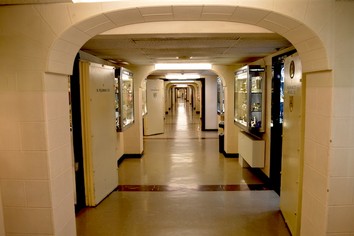 It is the biggest gallery with shops for retail sale of antique silverware. Behind the huge one-metre-thick security door, and beneath the silver vaults, as the name quite literally suggests, one may find all sorts of things, ranging from the most common of objects, such as salt shakers, egg holders, cutlery, candle holders, teacups, paper-weights, to more refined items, such as stylish cocktail stirrers, Champaign, or extravagant armchairs built in silver. In 1876 it used to be a deposit for precious objects, and then later it became a shop. For the last fifty years it has been possible to find items from each and every epoch and style exhibited here. It is an interesting and unusual place to explore, also because of its impressive size. One can purchase items, if one wishes to as well as the silverware, one may also find Sheffield Plate and Silver Plate, which is not quite so expensive but it is also a place where one may exchange or sell unwanted items.
It is the biggest gallery with shops for retail sale of antique silverware. Behind the huge one-metre-thick security door, and beneath the silver vaults, as the name quite literally suggests, one may find all sorts of things, ranging from the most common of objects, such as salt shakers, egg holders, cutlery, candle holders, teacups, paper-weights, to more refined items, such as stylish cocktail stirrers, Champaign, or extravagant armchairs built in silver. In 1876 it used to be a deposit for precious objects, and then later it became a shop. For the last fifty years it has been possible to find items from each and every epoch and style exhibited here. It is an interesting and unusual place to explore, also because of its impressive size. One can purchase items, if one wishes to as well as the silverware, one may also find Sheffield Plate and Silver Plate, which is not quite so expensive but it is also a place where one may exchange or sell unwanted items. HUNTERIAN MUSEUM
35-43 LINCOLN'S INN FIELDS
UNDERGROUND: HOLBORN
As early as the XIV Century, the Guild of Surgeons was based in this spot, and persisted in its attempts to resolve the ongoing dispute with the barber-surgeons. Later, in 1745, the surgeons split up with the barber-surgeons with the intention of improving the standards of the profession. By 1799 the government had acquired John Hunter's anatomy and physiology collection and donated it to the College.
This collection formed the foundation for the current collection and from there on, was gradually enhanced in time. The museum exhibits thousands of specimens, some more macabre than others: mummified hands, teeth, skulls, human or animal organs preserved in alcohol or formaldehyde, models of dissections, bones of people afflicted by osteoporosis, and the skeletons of feotuses. As far as skeletons are concerned, also to be found here is that of the Irish giant Charles Byrne, who was two metres and thirty-four centimetres tall. Byrne had tried in vain to oppose an undesirable post-mortem fate. He had asked to be buried under the waves of the sea. Unfortunately the fishermen who were supposed to take care of his burial were easily bribed and were more than happy to hand his corpse over to Hunter for five hundred pounds. Also many historical surgery tools are part of the collection, as well as some paintings, drawings, and sculptures.
The building has a neoclassical facade with a porch of six pillars, which managed to survive a fire bomb in 1941.
THE CHURCH OF LEPERS AND THE PLAGUE
ST GILES HIGH STREET
UNDERGROUND: TOTTENHAM COURT ROAD
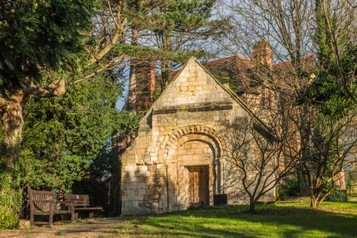 The Church of St Giles was founded at the beginning of the Thirteenth Century when Matilda, wife of Henry I, first opened a hospital for lepers in the north-western fields of London. It was established in memory of St Giles, the patron saint of those unfortunate souls. The baptismal font was drawn in 1810 by John Soane and graciously decorated with honeysuckle and a Greek frieze. Byron's daughter, Allegra, and two of Shelley's offspring, William and Clara, were all baptised here. There are a few interesting funeral monuments, amongst which, worthy of noting, is one of them in memory of George Chapman, whose translation of Homer inspired Keats' sonnet. His monument, which is supposed to have been designed by Inigo Jones, is shaped like a Roman altar. Near the door, there is a model of the Flitcroft church, and in the tympanum at the entry to the cemetery, there is a detailed and rather alarming Resurrection of the Dead, from 1687. It was in this parish that in 1665 the bubonic plague broke out.
The Church of St Giles was founded at the beginning of the Thirteenth Century when Matilda, wife of Henry I, first opened a hospital for lepers in the north-western fields of London. It was established in memory of St Giles, the patron saint of those unfortunate souls. The baptismal font was drawn in 1810 by John Soane and graciously decorated with honeysuckle and a Greek frieze. Byron's daughter, Allegra, and two of Shelley's offspring, William and Clara, were all baptised here. There are a few interesting funeral monuments, amongst which, worthy of noting, is one of them in memory of George Chapman, whose translation of Homer inspired Keats' sonnet. His monument, which is supposed to have been designed by Inigo Jones, is shaped like a Roman altar. Near the door, there is a model of the Flitcroft church, and in the tympanum at the entry to the cemetery, there is a detailed and rather alarming Resurrection of the Dead, from 1687. It was in this parish that in 1665 the bubonic plague broke out. In Bloomsbury Way, at the corner with New Oxford Street, stands St George's Church, designed by the architect Nicholas Hawksmoor, who belonged to the English baroque movement, the same architect who built St Alphege in Greenwich and Christ Church at Spitalfields.
The church was opened in 2006, after five years' restoration, and is now a lively centre for concerts and art exhibitions , located near the British Museum. There is also a permanent multimedia exhibition, called Hawksmoor & Bloomsbury.
THE SKYSCRAPER OF CENTRE POINT
101-103, NEW OXFORD STREET
UNDERGROUND: TOTTENHAM COURT ROAD
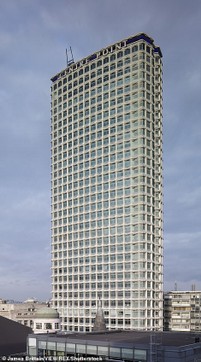 The glass and cement tower of Centre Point was designed by Richard Seifert and is almost one hundred and twenty metres high. The place was once taken up by a scaffold. With its thirty-two floors, it was one of the first skyscrapers built in London and caused a lot of controversy at the time. It was destined for use in the form of offices, and the owner left it unused and empty for many years because he wished to rent it all together to a single company. In 2005 it changed ownership.
The glass and cement tower of Centre Point was designed by Richard Seifert and is almost one hundred and twenty metres high. The place was once taken up by a scaffold. With its thirty-two floors, it was one of the first skyscrapers built in London and caused a lot of controversy at the time. It was destined for use in the form of offices, and the owner left it unused and empty for many years because he wished to rent it all together to a single company. In 2005 it changed ownership. At the base of the building there are some half-moon figures, assembled on stands. These are in fact fountains, built in 1963 by the architect Dernbach-Mayen. When water is running they are quite spectacular but more often than not they are turned off, and used to place platforms for actors, singers, and acrobats.
GRANT ZOOLOGY MUSEUM
21, UNIVERSITY STREET
UNDERGROUND: WARREN STREET
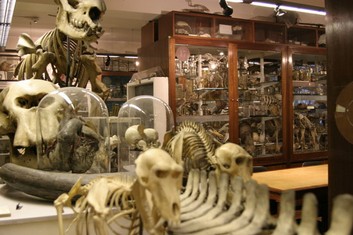 In the Rockfeller Building there is a small museum dedicated to the zoology professor, Robert Edmond Grant, friend and mentor of Charles Darwin. There are a good fifty-five thousand specimens belonging to the animal kingdom, including skeletons of rare or extinct animals, amongst which the Malaysian Dugong, the quagga, a zebra from South Africa, and the Tasmanian wolf (or Thylacine), which became extinct in 1936. One may also observe the bones of the Dodo from the Mauritius Isles, the big famous extinct bird, which was incapable of flying.
In the Rockfeller Building there is a small museum dedicated to the zoology professor, Robert Edmond Grant, friend and mentor of Charles Darwin. There are a good fifty-five thousand specimens belonging to the animal kingdom, including skeletons of rare or extinct animals, amongst which the Malaysian Dugong, the quagga, a zebra from South Africa, and the Tasmanian wolf (or Thylacine), which became extinct in 1936. One may also observe the bones of the Dodo from the Mauritius Isles, the big famous extinct bird, which was incapable of flying.Other interesting sights are for example the egg of an elephant bird from Madagascar, a Mammoth tooth dating back to at least twelve thousand years ago, some elephant skulls, and the skeleton of a giant anaconda. Some jars with formalin contain the heads of mammals, elephant hearts, and animal foetus, which are perhaps a little shocking. The museum also contains glass reproductions of jellyfish, sea anemones, gastropods, cephalopods, and holothuriae such as the sea cucumber, manufactured in 1800 with great skill and ability by Leopold and Rudolf Blaschka, from Czechoslovakia. It is a smallish museum, which can be visited within an hour, yet it really is worth the while.
THE PETRIE EGYPTIAN ARCHAEOLOGY MUSEUM
MALET PLACE
UNDERGROUND: GOODGE STREET
At the University College there is a museum dedicated to Flinders Petrie, who was the first professor at the faculty of Archaeology. The museum hosts around eighty thousand items, which make up one of the largest collections of Egyptian and Sudanese archaeology. Through them, life in the Nile Valley has been reconstructed starting from prehistory, passing through the time of Pharaohs, the Ptolemaic age, the Roman age, and lastly the during the age of the Copts. One piece of linen in particular dates back to five thousand years before Christ.
One may also witness some of the first existing metal utensils, as well as some scrolls, hieroglyphics, a dress made from small pearls once belonging to a dancer in the age of pyramids, some armour, sandals from ancient Roman times, tiles, sculptures, frescos, mummies, amulets, and various forms of ceramic art. A bizarre curiosity is the marble bas-relief of the god Min, one of the oldest in Egypt. The god of fertility is represented, quite aptly, with a long erect penis.
Soirées and exhibitions are organized here, such as the one on Flinders Petrie and Francis Galton, during which the application of the racial theories was examined in the field of archaeology.
DICKENS' HOUSE MUSEUM
48, DOUGHTY STREET
UNDERGROUND: RUSSELL SQUARE
The writer lived in the house in querstion from March 1837 to December 1839. During his stay here, he wrote The Pickwick Papers, Oliver Twist, Nicholas Nickleby, and also started writing Barnaby Rudge. This is where Mary Hogarth, his seventeen-year-old sister-in-law suddenly died. In 1925, the house was purchased by the society of friends of Dickens, and filled with a vast collection of antique items dating back to that period. Also the first editions of his books are to be found here, as well as his manuscripts, letters, and a table covered in red velvet which the writer used for his public reading sessions.
In one of the rooms of the basement floor, a kitchen has been reconstructed, similar to that of Manor Farm, where Mr Pickwick used to spend Christmas. Dickens came to live here after his first year of marriage, at the age of twenty five. At the time, the street was private, and was supervised at both ends by a couple of liveried gatekeepers with top hats, who had the duty of keeping inquisitive passers-by out.
The museum was opened in 1925, and was made up of ten rooms with Regency-style furniture, with leather armchairs and cushioned chairs, a table with three legs, and a large rectangular table. The golden-framed mirror hanging over the chimney place and the brass fireguard were both chosen by Dickens himself. Also found exhibited are the illustrations of his books and the original copy of Little Wooden Midshipman.
THE GOLDBEATERS HOUSE
MANETTE STREET
UNDERGROUND: WARREN STREET, GOODGE STREET
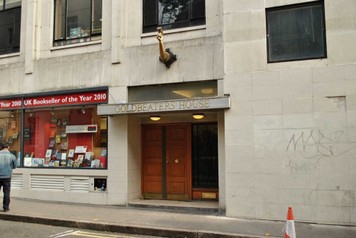 The area known as Fitzrovia, north of Oxford Street and west of Tottenham Court Road, is famous for its artists and writers who lived at the start of the Twentieth Century, amongst which George Orwell. One of the more fascinating industries of the zone was that of gold leaf production.
The area known as Fitzrovia, north of Oxford Street and west of Tottenham Court Road, is famous for its artists and writers who lived at the start of the Twentieth Century, amongst which George Orwell. One of the more fascinating industries of the zone was that of gold leaf production. George Manning Whiley was a goldbeater who had worked in Whitfield Street since 1896. He became rich and in 1919 commissioned a building known today as Goldbeaters House. He assigned the construction works to the architect Ernest H. Abbott, of whom little is known. The facade bears capital letters which incorporate the tools of the trade. The building has risked demolition a number of times, however the inhabitants of the neighbourhood have always put up a fight and managed to obtain an order of preservation. Today it is occupied by offices.
In the nearby Goodge Street, at number 56, there is a fine Mexican restaurant, Benito's Hat. On the sturdy wooden tables, burritos and tacos are served, made with soft tortillas filled with saucy meat with black beans. From the 31st October to 2nd November, all those who visit with a theme costume or make up receives a 50% discount on the already modest price.
MONUMENT IN MEMORY OF GANDHI
TAVISTOCK SQUARE
UNDERGROUND: RUSSELL SQUARE
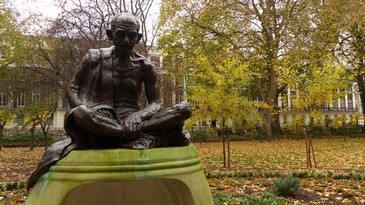 The monument commemorating Gandhi, an apostle of non-violence and catalyser of civil disobedience, was erected in 1968 and was an accomplishment of Fredda Brilliant. It was inaugurated by Harold Wilson. The bronze statue portrays Gandhi sitting cross-legged at the summit of a plinth. At his feet, lie fresh flowers, which are continually replaced. Churchill once defined him as a 'naked fakir', yet it was he, Gandhi who led his nation to independence from the United Kingdom, on 15th August 1947. Tragically, a Hindu fanatic assassinated him as he was attempting to establish a peaceful agreement between Hindu and Muslim factions, just after the end of the Indian Civil War.
The monument commemorating Gandhi, an apostle of non-violence and catalyser of civil disobedience, was erected in 1968 and was an accomplishment of Fredda Brilliant. It was inaugurated by Harold Wilson. The bronze statue portrays Gandhi sitting cross-legged at the summit of a plinth. At his feet, lie fresh flowers, which are continually replaced. Churchill once defined him as a 'naked fakir', yet it was he, Gandhi who led his nation to independence from the United Kingdom, on 15th August 1947. Tragically, a Hindu fanatic assassinated him as he was attempting to establish a peaceful agreement between Hindu and Muslim factions, just after the end of the Indian Civil War. Remaining on the subject of India, amid the web of streets around Drummond Street, there is a small village made up of vegetarian restaurants from Southern Indian Cuisine. A nice area, peaceful and unusual. At number 133 of Drummond Street we find the Ravi Shankar, where the belphoori is particularly renowned and appreciated, made with spicy rice and yoghurt.
KING'S CROSS STATION
EUSTON ROAD
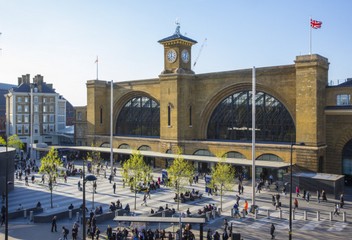 The name comes from a nearby zone where a statue of George IV once stood, although it was demolished in 1845. The project was carried out by Lewis Cubitt and the construction area hosted a hospital. The building consisted of two enormous arched roofings, its two facades built in bricks, one used for arrivals and the other for departures. The Flying Scotsman would leave for Edinburgh every morning at 10 o'clock. Between the two warehouses stands a tall tower bearing a clock, which gets its origins from the Great Exhibition of 1851. In 2005 the station was completely renewed.
The name comes from a nearby zone where a statue of George IV once stood, although it was demolished in 1845. The project was carried out by Lewis Cubitt and the construction area hosted a hospital. The building consisted of two enormous arched roofings, its two facades built in bricks, one used for arrivals and the other for departures. The Flying Scotsman would leave for Edinburgh every morning at 10 o'clock. Between the two warehouses stands a tall tower bearing a clock, which gets its origins from the Great Exhibition of 1851. In 2005 the station was completely renewed. If one stands at the crossroads between Pentonville Road and Gray's Inn Road and looks upwards, one can see a small panoramic tower with portholes and a dizzying balcony, although it is not clear what the latter was once used for. In the local pubs of the area, it is said that a retired commanding officer of a ship with a manner such as that of Admiral Boom in Mary Poppins used to keep a telescope constantly trained on the station of King's Cross, which is just below.
ST PANCRAS STATION AND MIDLAND GRAND HOTEL
EUSTON ROAD
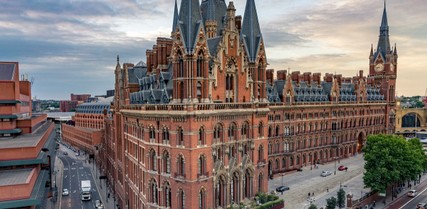 Today the name St Pancras only indicates a station and a church, whereas it once stood for a whole area. The old village, its name now forgotten and unused, once stood a short distance to the North of present-day Euston Road.
Today the name St Pancras only indicates a station and a church, whereas it once stood for a whole area. The old village, its name now forgotten and unused, once stood a short distance to the North of present-day Euston Road. Perhaps it bears some resemblance to the area which lies directly behind the station, rich of history and atmosphere, a Victorian atmosphere, and once known as Battle Bridge. To this day, the walls of the buildings bear the scabs of time, left by the steam engines. The bridge is named so because, according to tradition, it is here that Queen Boudica led the Celtic Iceni against the legions of Roman soldiers.
The station is made up of a single large warehouse, with an enormous iron arch, built by W. H. Barlow and R.M. Ordish. In 1872 George Gilbert Scott built the Midland Grand Hotel here. Its facade is the same as that of the station. It resembles a gothic castle, rich with decorations, steeples, and chimneys. It holds five hundred rooms and has an impressive flight of stairs, needed for elevating the railway above the level of Regent's Canal. All of the material was ordered from the Midlands, starting with the bricks, which came from Nottingham. It remains one of the best-known reference points in the city. Just north of St Pancras station, in Goods Way, there is a group of gasometers which date back to the Nineteenth Century. They ca be seen from a distance from the path that runs along the banks of Regent's Canal. In order to see them from a closer position, one must take the route of Good Way. Also from the windows of local trains leaving the station, one can make out their cylindrical silhouettes emerging gradually.
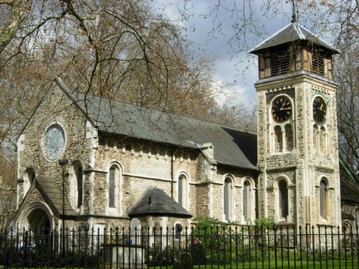 Church of St Pancras. St Pancras Old Church, in Pancras Road, is one of the most ancient sacred places in the capital. Some of its parts go back as far as the Seventeenth Century. It was later restored in 1847 by Gough and Roumieu. All that is left of the old structure is ogival window and two monuments, one of which is in memory of Philadelphia Wollaston, who died bearing a child in 1616, portrayed as she holds a child in her arms. The cemetery was turned into a public garden in 1877. The tombstones have been moved and arranged like spokes in a wheel around a central ash tree.
Church of St Pancras. St Pancras Old Church, in Pancras Road, is one of the most ancient sacred places in the capital. Some of its parts go back as far as the Seventeenth Century. It was later restored in 1847 by Gough and Roumieu. All that is left of the old structure is ogival window and two monuments, one of which is in memory of Philadelphia Wollaston, who died bearing a child in 1616, portrayed as she holds a child in her arms. The cemetery was turned into a public garden in 1877. The tombstones have been moved and arranged like spokes in a wheel around a central ash tree. St Pancras New Church, at the corner of Upper Woburn Place with Euston Road, was built by William Inwood and his son in 1820, when there was a great deal of interest in Greek architecture, which was also favoured by the exhibition of the Parthenon marble which took place at that time. Not all were in agreement with the idea of modelling a Christian church on a pagan temple. 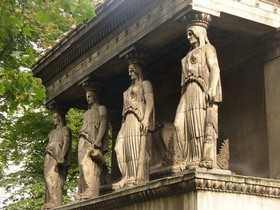 On the facade there is a porch sustained by six large ionic pillars, along the north and south side are two rows of giant Greek maidens, copied from the caryatids of the Erechtheion, on the Athens Acropolis. They were cast in Coade stone with a iron core by Charles Rossi who took three years to finish the job. The heavy traffic of Euston Road has blackened them a lot, and emphasized the incision mark which the sculptor had to make, after discovering that the statues were not the right size and were in fact too big. Indoors, the galleries are sustained by pillars decorated with lotus flowers. The pulpit has been inlaid in the wood of an oak tree from the forest of Hainault.
On the facade there is a porch sustained by six large ionic pillars, along the north and south side are two rows of giant Greek maidens, copied from the caryatids of the Erechtheion, on the Athens Acropolis. They were cast in Coade stone with a iron core by Charles Rossi who took three years to finish the job. The heavy traffic of Euston Road has blackened them a lot, and emphasized the incision mark which the sculptor had to make, after discovering that the statues were not the right size and were in fact too big. Indoors, the galleries are sustained by pillars decorated with lotus flowers. The pulpit has been inlaid in the wood of an oak tree from the forest of Hainault.
 On the facade there is a porch sustained by six large ionic pillars, along the north and south side are two rows of giant Greek maidens, copied from the caryatids of the Erechtheion, on the Athens Acropolis. They were cast in Coade stone with a iron core by Charles Rossi who took three years to finish the job. The heavy traffic of Euston Road has blackened them a lot, and emphasized the incision mark which the sculptor had to make, after discovering that the statues were not the right size and were in fact too big. Indoors, the galleries are sustained by pillars decorated with lotus flowers. The pulpit has been inlaid in the wood of an oak tree from the forest of Hainault.
On the facade there is a porch sustained by six large ionic pillars, along the north and south side are two rows of giant Greek maidens, copied from the caryatids of the Erechtheion, on the Athens Acropolis. They were cast in Coade stone with a iron core by Charles Rossi who took three years to finish the job. The heavy traffic of Euston Road has blackened them a lot, and emphasized the incision mark which the sculptor had to make, after discovering that the statues were not the right size and were in fact too big. Indoors, the galleries are sustained by pillars decorated with lotus flowers. The pulpit has been inlaid in the wood of an oak tree from the forest of Hainault.CANAL MUSEUM
12-13 NEW WHARF ROAD
UNDERGROUND: KING'S CROSS
At the Canal Museum there are reconstructions and descriptions of many things pertaining to it: the interior of a cabin, transported loads, images of people who lived or worked there and horses towing barges. The area where the museum stands, used to host the wells used for preserving ice, imported from Norway. The wells were able to hold a quite a few tons of ice.
The warehouse was built in 1862 by Carlo Gatti, the famous ice-cream maker, and here also the history of ice cream is illustrated. In this manner, the museum has the double function of safeguarding the memory of what it once meant to work on the canals, but also the work that was carried out inside the building, which was the reason it had been built.
From the window panes and terrace one can enjoy a pleasant view over the canal, with its cranes and loading pilot houses which have remained in their place.
EUSTON STATION
EUSTON ROAD
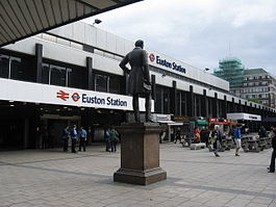 Here, as in many other places, the railway transformed the life of the surrounding society profoundly, giving it faith in technical and industrial progress. Euston was one of the three railroads which, at the beginning of the Nineteenth Century, represented the northern limit of the city. Exactly what this meant for the residents can be surmised in Chapter VI of Dombey and Son by Dickens, who was living in Doughty Street at the time, while the line for Birmingham was being built, later to open on the 20th July 1837. The station had been planned by Robert Stephenson. At the entrance there was a great vault, a passage with a Dorian arch, created by Hardwick.
Here, as in many other places, the railway transformed the life of the surrounding society profoundly, giving it faith in technical and industrial progress. Euston was one of the three railroads which, at the beginning of the Nineteenth Century, represented the northern limit of the city. Exactly what this meant for the residents can be surmised in Chapter VI of Dombey and Son by Dickens, who was living in Doughty Street at the time, while the line for Birmingham was being built, later to open on the 20th July 1837. The station had been planned by Robert Stephenson. At the entrance there was a great vault, a passage with a Dorian arch, created by Hardwick. 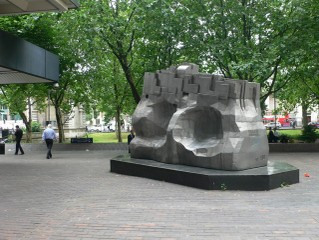 The name was carved in gold letters beneath the pediment of the splendid neo-Greek-style hall. Unfortunately, when the station was rebuilt in 1947, the great vault was demolished. In front of the station stands a statue of Stephenson, carried out by Carlo Marochetti from Turin. There is also one by Edoardo Paolozzi known as Piscator. Stephenson had also designed the Round House of Chalk Farm Road, in order to make a steam engine deposit out of it. Nowadays the building is used for theatre shows and concerts.
The name was carved in gold letters beneath the pediment of the splendid neo-Greek-style hall. Unfortunately, when the station was rebuilt in 1947, the great vault was demolished. In front of the station stands a statue of Stephenson, carried out by Carlo Marochetti from Turin. There is also one by Edoardo Paolozzi known as Piscator. Stephenson had also designed the Round House of Chalk Farm Road, in order to make a steam engine deposit out of it. Nowadays the building is used for theatre shows and concerts.A WATERFALL OF PEARLS
215, EUSTON ROAD
UNDERGROUND: EUSTON SQUARE
 The Gibbs Building is the main office for the biomedical research society, Wellcome Trust. There are many works of art to be found here, but the one in front of the entrance is surely the most spectacular. It is about 100 feet high, and was carried out by Thomas Heatherwick. The artist decided to use a liquid material which becomes solid after being poured into cold water, becoming a sculpture in this case. This material was also filled with one hundred and fifty small glass spheres, treated in such a way as to create translucent reflections, like a rainbow of changing shapes and colours. These are used in central Europe on New Year's Eve to predict the fortune of the new year ahead. There are also guided tours to admire the masterpiece from the top floor, which can be reached by means of a glass elevator. The sculpture is beautiful in the evening, when it is lit up and becomes a cloud of light.
The Gibbs Building is the main office for the biomedical research society, Wellcome Trust. There are many works of art to be found here, but the one in front of the entrance is surely the most spectacular. It is about 100 feet high, and was carried out by Thomas Heatherwick. The artist decided to use a liquid material which becomes solid after being poured into cold water, becoming a sculpture in this case. This material was also filled with one hundred and fifty small glass spheres, treated in such a way as to create translucent reflections, like a rainbow of changing shapes and colours. These are used in central Europe on New Year's Eve to predict the fortune of the new year ahead. There are also guided tours to admire the masterpiece from the top floor, which can be reached by means of a glass elevator. The sculpture is beautiful in the evening, when it is lit up and becomes a cloud of light. 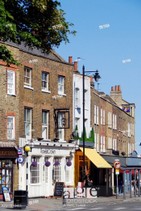 The Highgate neighbourhood has preserved the atmosphere of a village, with its small Nineteenth-century houses. The name comes from the barrier of middle-age toll erected on the Old North Road.
The Highgate neighbourhood has preserved the atmosphere of a village, with its small Nineteenth-century houses. The name comes from the barrier of middle-age toll erected on the Old North Road. Thomas Howard's palace, which is no longer present today, was the setting for the death of the philosopher Francis Bacon: he passed away on 9th April 1626 having caught a cold after an experiment. He was stuffing a chicken with snow, to see if the refrigeration would preserve the carcass.
One of the remaining woodland areas is called Queen's wood and is near the underground station. It is a wide valley of old trees with a dried-up lake in the centre. In 1890, a great fight was carried forward with the objective of safeguarding the wood and the ecclesiastical commissioners were paid in order to prevent the wood from perishing. The area is not overly taken care of; it is in fact a place of wild vegetation, inhabited by foxes and many birds. The tea house near Muswell Hill Road serves a delicious mix of hot and cold dishes, all of them of organic production.
HIGHGATE CEMETERY
SWAIN'S LANE
UNDERGROUND: ARCHWAY, HIGHGATE
This marvellously-restored cemetery may only be visited through guided tours. One of the most unusual tombs is that of George Wombell. The inscription states that he was the owner of a private zoo, a menagerie of ferocious beasts. In actual fact, Wombell used to display the animals in shows, and would not hesitate to exhibit rounds of fighting between canine and feline species. He had named two of his lions Nero and Wallace. He also exhibited elephants, which at the time were a complete novelty. In 1826 the menagerie, managed by Wombell's widow, was in Leicester. The lion portrayed on Wombell's tomb somewhat seems to bear an expression of resignation.
HUNTING BATS IN WATERLOW PARK
130, HIGHGATE HILL
UNDERGROUND: ARCHWAY
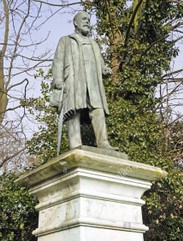 This is where the country residence of Sydney Waterlow was located , a philanthropist who had opened the gates of the park to the public, making it accessible and available to people who were not fortunate enough to be able to afford a house with a garden. Nowadays the keeping of the park, which is located on higher ground, has been entrusted to the public administration of Camden. This area is one of the most beautiful in London, and sports a small aviary, and also a number of beds, constantly filled with herbs and flowers of all sorts. In memory of Waterlow, a statue has been put up, which portrays him holding an umbrella in his hand. It is the only monument of its kind to be found here.
This is where the country residence of Sydney Waterlow was located , a philanthropist who had opened the gates of the park to the public, making it accessible and available to people who were not fortunate enough to be able to afford a house with a garden. Nowadays the keeping of the park, which is located on higher ground, has been entrusted to the public administration of Camden. This area is one of the most beautiful in London, and sports a small aviary, and also a number of beds, constantly filled with herbs and flowers of all sorts. In memory of Waterlow, a statue has been put up, which portrays him holding an umbrella in his hand. It is the only monument of its kind to be found here.The Sixteenth-century Lauderdale House looms in the park, and has been converted into an art centre. Here one may find exhibitions, events, rehearsed shows, and lastly a tea room and restaurant.
During the months of July and August, thrill-seeking souls in search of adventure can go on amazing walks, especially at night time, which is excellent for spotting bats. Many of those who take part in these walks are armed with detectors specifically made for identifying these creatures, and once they have been identified, it is possible to distinguish each one uniquely depending on the frequency of their shrieks. During the day time, from Waterlow Park one can enjoy a breathtaking view of London.
WHITTINGTON'S CAT
HIGHGATE HILL
UNDERGROUND: HIGHGATE
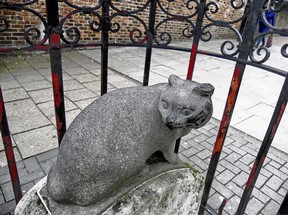 Near the building which stands at the crossroads with Archway Road, which bears two domes made in green copper and is home to a Catholic church, stands a stone cat sitting on the pavement. It is said thatit was right in this spot that Richard Whittington, who was about to leave London for good, heard the bells of the City calling for him to remain and telling him that he would soon find fame and fortune there. He heeded them and later became the lord mayor of the City. In order to repay life for the good fortune he had enjoyed, he left a sum of money for the construction of houses for poor people right in this very spot.
Near the building which stands at the crossroads with Archway Road, which bears two domes made in green copper and is home to a Catholic church, stands a stone cat sitting on the pavement. It is said thatit was right in this spot that Richard Whittington, who was about to leave London for good, heard the bells of the City calling for him to remain and telling him that he would soon find fame and fortune there. He heeded them and later became the lord mayor of the City. In order to repay life for the good fortune he had enjoyed, he left a sum of money for the construction of houses for poor people right in this very spot. 
